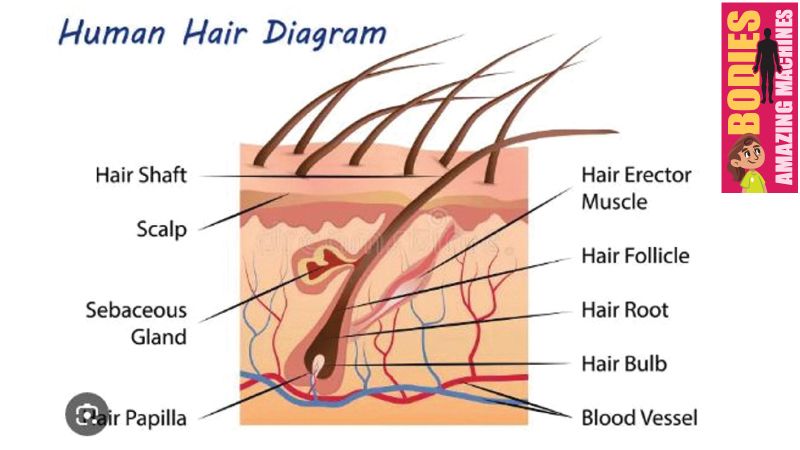Have you ever wondered what hair really is? Why do we have it? Why is it straight, curly, black, brown, or even bright pink (when dyed)? Let’s take a fun look at hair, one of our bodies most amazing creations.
What is hair?
Hair is made of a strong protein called keratin. It’s the same stuff that makes up your fingernails, toenails, and even animal horns and feathers. Hair grows out of tiny holes in your skin called follicles. You have follicles all over your body—even on your toes and arms—but the hair on your head is usually the longest and thickest.
How does hair grow?
Hair grows from the bottom of the follicle, under your skin. Blood vessels feed the root and give it the oxygen and nutrients it needs to grow. Once the hair pushes up through the skin, it pops out—and that’s the part we can see. The hair you comb, style, or braid is actually dead, which is why cutting it doesn’t hurt.
Most people’s hair grows about half an inch (1.25 cm) every month. That’s about 6 inches (15 cm) a year.
Why are there so many hair colours?
Hair comes in lots of natural colours: black, brown, blonde, red, and even gray or white as people get older. Hair colour is decided by something in our bodies called melanin. More melanin means darker hair. Less melanin gives you lighter hair. Some children even have red or auburn hair thanks to special genes passed down from their parents.
And of course, some people love to dye their hair in fun colours like blue, purple, or even like a rainbow.
Why do we have hair?
Hair keeps us warm, protects our scalp from the sun, and helps us express our style. Eyelashes protect our eyes from dust. Eyebrows help catch sweat. Hair on your head keeps your brain cosy and makes you unique.
In some cultures, hairstyles are very important. They can show your personality, beliefs, age, or even traditions. Braids, buns, afros, ponytails, or buzz cuts—there are so many ways to wear your hair.
Why does hair turn white?
Hair turns grey because of something called melanin — that’s the natural pigment (colour) that gives your hair its colour, like black, brown, blonde, or red. Melanin is made up of special cells in your hair follicles called melanocytes.
As we get older, those melanocytes start to slow down or stop working. That means they make less melanin, and without melanin, our hair loses its colour and turns grey, silver, or even white.
It’s totally normal and happens to everyone eventually. Some people start getting grey hair in their 30s or 40s, while others see it earlier or later. It’s also partly genetic, which means it runs in families—so if your parents got grey hair early, you might too.
How should we take care of our hair?
Taking care of hair is important to keep it shiny and healthy. Here’s how:
• Wash it gently with shampoo when it’s dirty
• Brush or comb it carefully to avoid tangles
• Trim it regularly to avoid split ends
• Avoid too much heat from dryers or straighteners
• Eat healthy foods like fruits, veggies, leafy greens, eggs, fish and nuts—they help your hair grow strong and healthy.
Everyone’s hair is special
No two heads of hair are exactly the same. Some people have thick hair, others thin. Some hair is curly like springs, others are super straight. Despite the differences all hair is beautiful—it’s fun to see the diversity, otherwise imagine if everyone had the same style or type of hair, how boring that would be.
So, next time you brush your hair or admire a fun hairstyle, remember how amazing, strong, and cool your hair really is.
Fun hair facts
• You have about 100,000 strands of hair on your head
• It’s normal to lose 50 to 100 a day—don’t worry, new ones grow back.
• Hair is the second-fastest-growing tissue in your body (after bone marrow).
• The world’s longest hair ever recorded was over 18 feet long.









